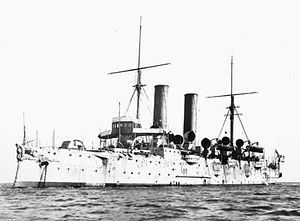Name HMS Blenheim Commissioned 1891 Reclassified Depot ship 1907 Launched 5 July 1890 Weight 9,297 tons | Laid down October 1888 Decommissioned 1926 Construction started October 1888 Length 114 m Displacement 8.301 million kg | |
 | ||
Fate Sold for breaking up 13 July 1926 Builder Thames Ironworks and Shipbuilding Company | ||
HMS Blenheim was a Blake-class first class protected cruiser that served in the Royal Navy from 1890–1926. She was built by Thames Ironworks & Shipbuilding Company at Leamouth, London. The ship was named after the Battle of Blenheim.
Contents
Description
Launched 5 July 1890, she displaced 9,150 tons and her steel hull measured 375 feet (114 m) (length) and 65 feet (20 m) (beam) with 20,000 indicated horsepower (15,000 kW) turning 2 propellers giving a top speed of 22 knots (41 km/h). Her main armament was two BL 9.2 inch Mk VI guns (234 mm) and six QF 6 inch guns (152 mm) on the upper deck, and four QF 6 inch guns in 150 mm compound armoured casemates on the main deck. She also carried sixteen 3-pounders, and four 14 inch torpedo tubes (two submerged and two above water).
Service history
She was commissioned at Chatham on 1 January 1891.
Sitting Canadian Prime Minister Sir John Thompson died in England, just after being named to Queen Victoria's Privy Council in 1894 and was repatriated to Halifax, Nova Scotia by Blenheim, which was painted black for the occasion.
Prince Henry of Battenberg died from malaria while on active duty onboard HMS Blonde off Sierra Leone in 1896. Blenheim repatriated his body from the Canary Islands. Queen Victoria appointed the commanding officer Captain Edmund S. Poe to the fourth class of the Royal Victorian Order as a mark of appreciation for this service.
In 1901 she was placed under the command of Captain Frank Hannam Henderson, to serve at the China station to support the British position during the Boxer Rebellion. In June 1902 she visited Nagasaki, and the following month Captain Frederick George Stopford was appointed in command.
She served as a cruiser with the Channel Squadron until May 1908 when she joined the Mediterranean Fleet as a destroyer depot ship. Whilst being used as a depot ship, future Rear-Admiral and VC winner Eric Gascoigne Robinson served aboard her. She was sent to Mudros in March 1915 in support of the Mediterranean Expeditionary Force at the Battle of Gallipoli. Later that year, Blenheim repatriated former Canadian Prime Minister Sir Charles Tupper who had died in England in 1915 to Halifax.
She was scrapped in 1926 at Pembroke Dock.
